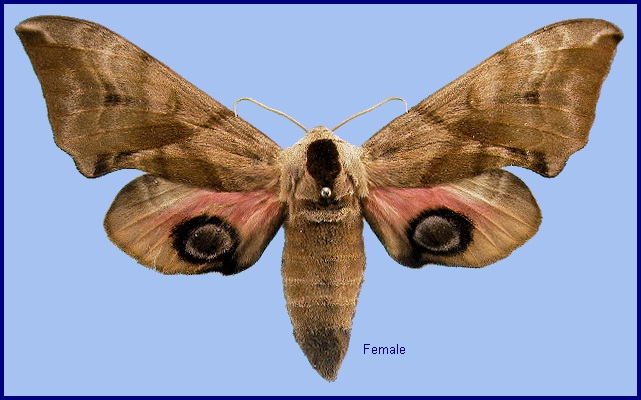
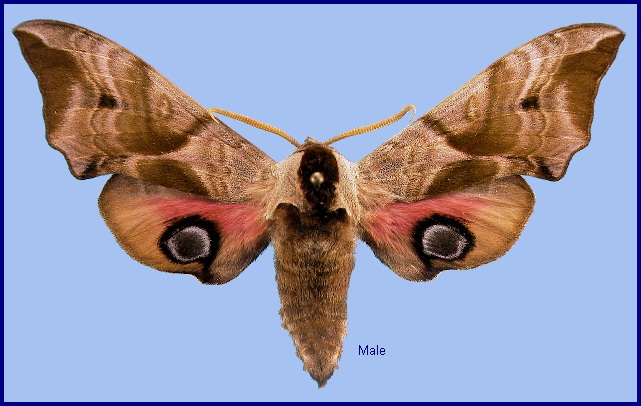
Sphinx ocellata Linnaeus, 1758, Syst. Nat. (Edn 10) 1: 489. Type locality: not stated [Europe].
Synonym. Sphinx ocellata Linnaeus, 1758.
Synonym. Sphinx semipavo Retzius, 1783.
Synonym. Sphinx salicis Hübner, 1796.
Synonym. Smerinthus ocellata cinerascens Staudinger, 1879.
Synonym. Smerinthus ocellata rosea Bartel, 1900.
Synonym. Smerinthus ocellata albescens Tutt, 1902.
Synonym. Smerinthus ocellata pallida Tutt, 1902.
Synonym. Smerinthus ocellata caeca Tutt, 1902.
Synonym. Smerinthus ocellata diluta Closs, 1917.
Synonym. Smerinthus ocellata grisea Closs, 1917.
Synonym. Smerinthus ocellata ollivryi Oberthür, 1920.
Synonym. Smerinthus ocellata flavescens Neumann, 1930.
Synonym. Smerinthus ocellata kainiti Knop, 1937.
Synonym. Smerinthus ocellata reducta Schnaider, 1950.
Synonym. Smerinthus ocellata monochromica Cockayne, 1953.
Synonym. Smerinthus ocellata biocellata Lempke, 1959.
Synonym. Smerinthus ocellata brunnescens Lempke, 1959.
Synonym. Smerinthus ocellata caerulocellata Lempke, 1959.
Synonym. Smerinthus ocellata deroseata Lempke, 1959.
Synonym. Smerinthus ocellata parvocellata Lempke, 1959.
Synonym. Smerinthus ocellata rufescens Lempke, 1959.
Synonym. Smerinthus ocellata uniformis Lempke, 1959.
Synonym. Smerinthus ocellata viridiocellata Lempke, 1959.
Synonym. Smerinthus visinskasi Zolotuhin & Saldaitis, 2009.
Wingspan: 70--95mm. Very similar in appearance to the other Palaearctic Smerinthus species but distinguished by the presence of an apical thorn on the foretibia, and a full, circular hindwing ocellus. In addition to variations in forewing pattern intensity, differences in colour are also to be found on the hindwing, where pink may be replaced by yellow (f. flavescens Neumann); grey (f. pallida Tutt); or white (f. albescens Tutt). In f. rosea Bartel, the pink is abnormally deep and often coupled with yellowish brown forewings; in f. ollivryi Oberthür, the ocellus may be replaced by a buff brown patch.

China: 23.iv (Yili area), 5.v (Shihezi); 22-24.vi (Altay City). Mongolia: 3-28.v (Altai Mountains, Khovd Province); 1-7.vi (Khovd Province). Russia: 25.v-10.vi (Altai); 26.vi-17.vii (Siberia).
OVUM: In Europe, pale green, becoming greyish white prior to hatching; oval (1.4 x 1.6mm), shiny and smooth. Laid singly or in pairs beneath leaves not more than 2m above the ground.
LARVA: Full-fed 70--80mm. In Europe dimorphic: bluish green or apple-green. On hatching, the young larva is about 5mm long, whitish green, with a pale pink horn. It clings tightly with all legs to a vein on the underside of a leaf. In the second instar, pale lateral stripes appear, the head becomes dorsally pointed and, when not feeding, it rests in a typical sphinx-like posture, holding on with the last three pairs of prolegs only. When so positioned beneath a leaf, the larva is very difficult to detect due to its excellent counter-shading. With growth, a number of changes take place: the horn gradually changes from pink, through purple, to blue in the final instar; the counter-shading becomes more noticeable; the dorsal surface becomes much paler than the ventral, with more of the prominent white or yellow tubercles; and the head eventually loses its pointed apex. Two colour forms are found: the commonest is bluish white with white lateral stripes and tubercles; the other, yellowish green with yellow markings and, occasionally, red blotches and stripe edging. Prior to pupation, all become suffused with brownish yellow before the larva wanders off to find a pupation site, which is usually some distance from the hostplant.
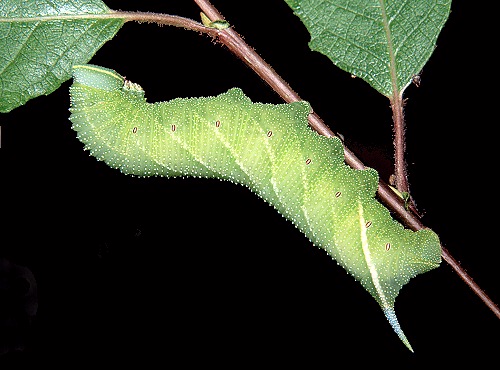
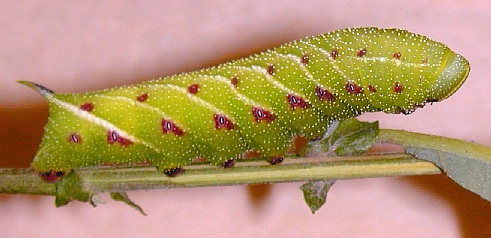
PUPA: 35--41mm. Rich, glossy blackish brown. Thickset, anteriorly blunted and tapering posteriorly, in shape resembling that of Laothoe populi (Linnaeus, 1758). Most are formed in an earthen cell 2--3 cm under the surface of the soil away from the hostplant. The overwintering stage.
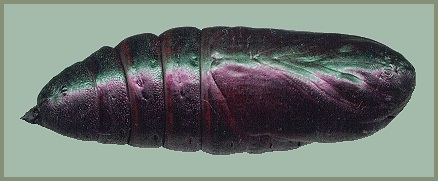
Larval hostplants. Unknown in China and Mongolia. In Europe, the major hostplants are Malus, Populus and Salix. Also found on numerous minor hostplants, including Alnus, Betula, Ligustrum, Prunus (especially P. spinosa), Tilia and Viburnum (Pittaway, 1995).
Unknown for the region.
China: Xinjiang (Shihezi; Tacheng; Yili area, near Yining; Altay City, 673m).
Mongolia: Khovd Province (River Bulgan, 10km east of Jarantaj; 50km N Uench, middle stream of River Uenchin; 30km S Altai Village, Bodonchijn River valley, Elkhony-Ekhen-Tal, 1200m (45°43' N; 92°05' E)).
Russia: Altai (Klyuchi; Gorno-Altaisk; Barnaul); Siberia (Kolomino; Bazoy; Tomsk; Novosibirsk).
Found throughout Europe (with the exeption of much of Scandinavia and the Baltic Republics), east through Russia as far as the Ob' river valley, and to eastern Kazakhstan and the Altai (Danner et al., 1998). The above records extend the distribution of Smerinthus ocellata ocellata into western Mongolia (Grosser, 1982) and NW China (SACS, XAUX) (see also Smerinthus planus planus) Walker, 1856.
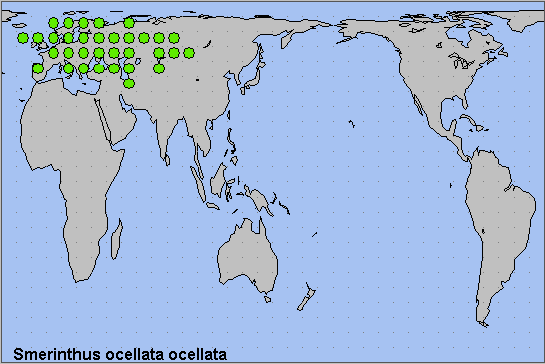
Holarctic; western Palaearctic region. Pleistocene refuge: Polycentric -- Pontomediterranean and Caspian refugia.
 Return to Sphingidae of the Eastern Palaearctic species list
Return to Sphingidae of the Eastern Palaearctic species list